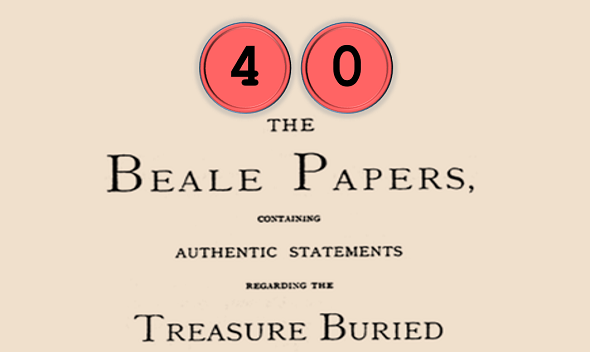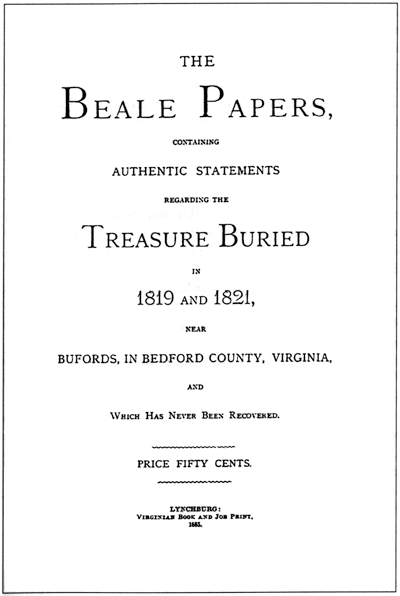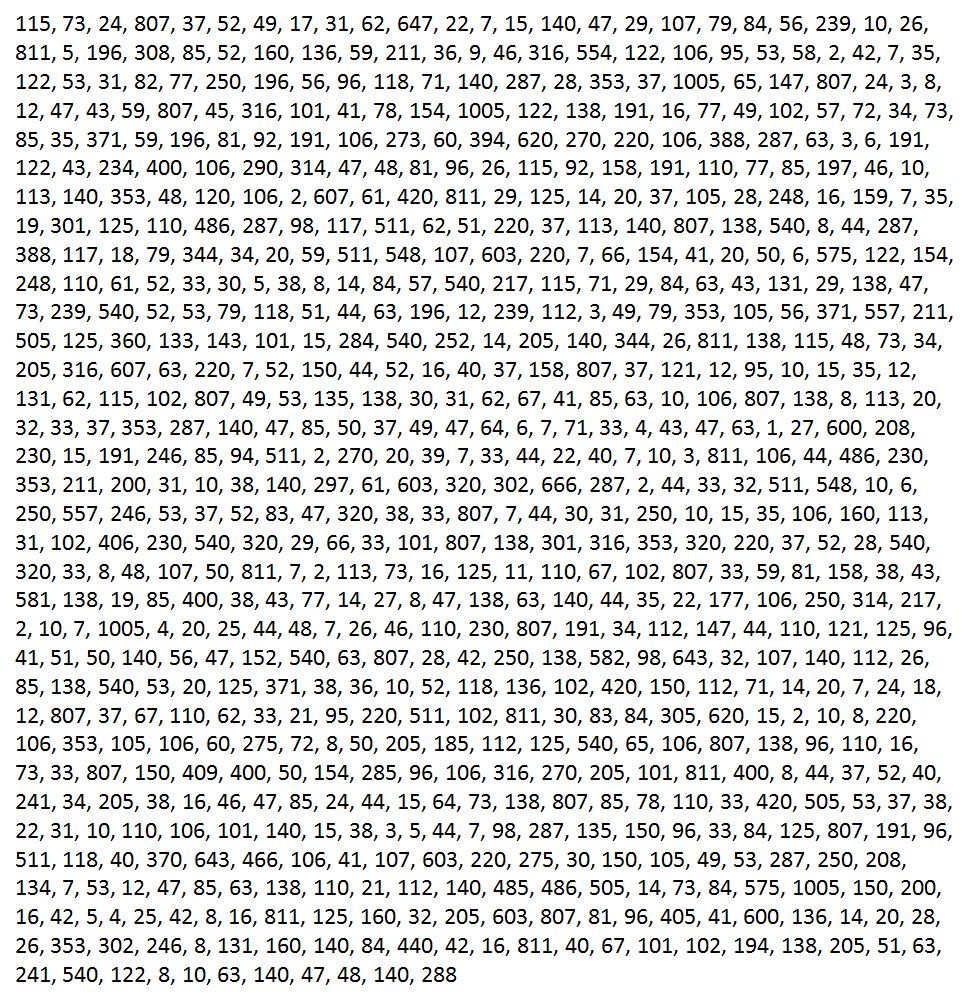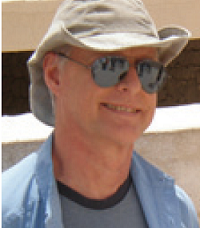The Beale cryptograms are the greatest hoax in crypto history. Generations of treasure hunters have tried to solve them and to find the hidden treasure, the location of which they allegedly describe. Nobody has ever been successfull, as the treasure simply does not exist.
Click here for the complete top 50 list
In 1885 a small publishing company located in Lynchburg, Virginia, published a book named The Beale Papers, which had the appearance of a trashy novel. The plot was a Wild West story about a number of buffalo hunters, who found gold in a canyon in New Mexico. One of the hunters left behind three encrypted notes that contain a description of the place where this gold was hidden.
There is one special thing about this book: the publisher, a James Ward, claimed that its content was true. Allegedly, the group of buffalo hunters actually existed, just like their gold treasure and the place where it was hidden. If one believes this story, the three cryptograms described in The Beale Papers actually lead to tons of gold – provided they can be deciphered. So far, only one of three notes has been broken. The cleartext turned out to be not sufficient for locating the hiding place of the treasure.
The story
The details of the Beale cryptograms have been described so many times before that I don’t want to write down this story again. Instead, I quote Wikipedia:
[The] treasure [was] buried by a man named Thomas J. Beale in a secret location in Bedford County, Virginia, in the 1820s. Beale entrusted a box containing the encrypted messages to a local innkeeper named Robert Morriss and then disappeared, never to be seen again. According to the story, the innkeeper opened the box 23 years later, and then decades after that gave the three encrypted ciphertexts to a friend before he died. The friend then spent the next twenty years of his life trying to decode the messages, and was able to solve only one of them which gave details of the treasure buried and the general location of the treasure. The unnamed friend then published all three ciphertexts in a pamphlet which was advertised for sale in the 1880s. Since the publication of the pamphlet, a number of attempts have been made to decode the two remaining ciphertexts and to locate the treasure, but all efforts have resulted in failure.
The cryptograms
Here is Beale cryptogram #1 (unsolved):
71 194 38 1701 89 76 11 83 1629 48 94 63 132 16 111 95 84 341 975 14 40 64 27 81 139 213 63 90 1120 8 15 3 126 2018 40 74 758 485 604 230 436 664 582 150 251 284 308 231 124 211 486 225 401 370 11 101 305 139 189 17 33 88 208 193 145 1 94 73 416 918 263 28 500 538 356 117 136 219 27 176 130 10 460 25 485 18 436 65 84 200 283 118 320 138 36 416 280 15 71 224 961 44 16 401 39 88 61 304 12 21 24 283 134 92 63 246 486 682 7 219 184 360 780 18 64 463 474 131 160 79 73 440 95 18 64 581 34 69 128 367 460 17 81 12 103 820 62 116 97 103 862 70 60 1317 471 540 208 121 890 346 36 150 59 568 614 13 120 63 219 812 2160 1780 99 35 18 21 136 872 15 28 170 88 4 30 44 112 18 147 436 195 320 37 122 113 6 140 8 120 305 42 58 461 44 106 301 13 408 680 93 86 116 530 82 568 9 102 38 416 89 71 216 728 965 818 2 38 121 195 14 326 148 234 18 55 131 234 361 824 5 81 623 48 961 19 26 33 10 1101 365 92 88 181 275 346 201 206 86 36 219 324 829 840 64 326 19 48 122 85 216 284 919 861 326 985 233 64 68 232 431 960 50 29 81 216 321 603 14 612 81 360 36 51 62 194 78 60 200 314 676 112 4 28 18 61 136 247 819 921 1060 464 895 10 6 66 119 38 41 49 602 423 962 302 294 875 78 14 23 111 109 62 31 501 823 216 280 34 24 150 1000 162 286 19 21 17 340 19 242 31 86 234 140 607 115 33 191 67 104 86 52 88 16 80 121 67 95 122 216 548 96 11 201 77 364 218 65 667 890 236 154 211 10 98 34 119 56 216 119 71 218 1164 1496 1817 51 39 210 36 3 19 540 232 22 141 617 84 290 80 46 207 411 150 29 38 46 172 85 194 39 261 543 897 624 18 212 416 127 931 19 4 63 96 12 101 418 16 140 230 460 538 19 27 88 612 1431 90 716 275 74 83 11 426 89 72 84 1300 1706 814 221 132 40 102 34 868 975 1101 84 16 79 23 16 81 122 324 403 912 227 936 447 55 86 34 43 212 107 96 314 264 1065 323 428 601 203 124 95 216 814 2906 654 820 2 301 112 176 213 71 87 96 202 35 10 2 41 17 84 221 736 820 214 11 60 760
Here’s #2 (solved):
The plaintext of cryptogram #2 reads as follows:
I have deposited in the county of Bedford, about four miles from Buford’s, in an excavation or vault, six feet below the surface of the ground, the following articles, belonging jointly to the parties whose names are given in number three, herewith:
The first deposit consisted of ten hundred and fourteen pounds of gold, and thirty-eight hundred and twelve pounds of silver, deposited Nov. eighteen nineteen. The second was made Dec. eighteen twenty-one, and consisted of nineteen hundred and seven pounds of gold, and twelve hundred and eighty-eight of silver; also jewels, obtained in St. Louis in exchange to save transportation, and valued at thirteen thousand dollars.
The above is securely packed in iron pots, with iron covers. The vault is roughly lined with stone, and the vessels rest on solid stone, and are covered with others. Paper number one describes the exact locality of the vault, so that no difficulty will be had in finding it.
This cleartext was encrypted using a substitution table based on the United States Declaration of Independence.
Here’s Beale cryptogram #3 (unsolved):
317 8 92 73 112 89 67 318 28 96107 41 631 78 146 397 118 98 114 246 348 116 74 88 12 65 32 14 81 19 76 121 216 85 33 66 15 108 68 77 43 24 122 96 117 36 211 301 15 44 11 46 89 18 136 68 317 28 90 82 304 71 43 221 198 176 310 319 81 99 264 380 56 37 319 2 44 53 28 44 75 98 102 37 85 107 117 64 88 136 48 151 99 175 89 315 326 78 96 214 218 311 43 89 51 90 75 128 96 33 28 103 84 65 26 41 246 84 270 98 116 32 59 74 66 69 240 15 8 121 20 77 89 31 11 106 81 191 224 328 18 75 52 82 117 201 39 23 217 27 21 84 35 54 109 128 49 77 88 1 81 217 64 55 83 116 251 269 311 96 54 32 120 18 132 102 219 211 84 150 219 275 312 64 10 106 87 75 47 21 29 37 81 44 18 126 115 132 160 181 203 76 81 299 314 337 351 96 11 28 97 318 238 106 24 93 3 19 17 26 60 73 88 14 126 138 234 286 297 321 365 264 19 22 84 56 107 98 123 111 214 136 7 33 45 40 13 28 46 42 107 196 227 344 198 203 247 116 19 8 212 230 31 6 328 65 48 52 59 41 122 33 117 11 18 25 71 36 45 83 76 89 92 31 65 70 83 96 27 33 44 50 61 24 112 136 149 176 180 194 143 171 205 296 87 12 44 51 89 98 34 41 208 173 66 9 35 16 95 8 113 175 90 56 203 19 177 183 206 157 200 218 260 291 305 618 951 320 18 124 78 65 19 32 124 48 53 57 84 96 207 244 66 82 119 71 11 86 77 213 54 82 316 245 303 86 97 106 212 18 37 15 81 89 16 7 81 39 96 14 43 216 118 29 55 109 136 172 213 64 8 227 304 611 221 364 819 375 128 296 1 18 53 76 10 15 23 19 71 84 120 134 66 73 89 96 230 48 77 26 101 127 936 218 439 178 171 61 226 313 215 102 18 167 262 114 218 66 59 48 27 19 13 82 48 162 119 34 127 139 34 128 129 74 63 120 11 54 61 73 92 180 66 75 101 124 265 89 96 126 274 896 917 434 461 235 890 312 413 328 381 96 105 217 66 118 22 77 64 42 12 7 55 24 83 67 97 109 121 135 181 203 219 228 256 21 34 77 319 374 382 675 684 717 864 203 4 18 92 16 63 82 22 46 55 69 74 112 134 186 175 119 213 416 312 343 264 119 186 218 343 417 845 951 124 209 49 617 856 924 936 72 19 28 11 35 42 40 66 85 94 112 65 82 115 119 236 244 186 172 112 85 6 56 38 44 85 72 32 47 63 96 124 217 314 319 221 644 817 821 934 922 416 975 10 22 18 46 137 181 101 39 86 103 116 138 164 212 218 296 815 380 412 460 495 675 820 952
Why it is a hoax
Many major crypto history experts (including David Kahn, Louis Kruh, and Craig Bauer) believe that the story of the Beale treasure including the cryptograms is a hoax. There are many good reasons for this view:
- The Ward book (i.e., a kind of trashy novel) is the only source for this story.
- It is unclear why Beale would have bothered writing three different ciphertexts for what is essentially a single message.
- Joe Nickell, a renowned forgery expert and (like me) a member of the skeptics movement, has analyzed the language of the Ward booklet and of Beale’s letters using stylometry. The result suggests that they may have been written by the same person.
- According to the Ward book, Robert Morriss was running the Washington Hotel in 1820. However, contemporary records show he did not start in that position until at least 1823.
In his Cryptologia article A Basic Probe of The Beale Cipher as a Bamboozlement, blog Louis Kruh gave a few more reasons why the Beale cryptograms are probably a fake:
Some other anomalies. After Ward received the papers from Morriss, according to his own words, he “arranged the papers in the order of their length, and numbered them. Note that the ciphers which had been identified by Ward as numbers 1, 2, and 3 contain 520, 763 and 618 elements respectively. Obviously, they are not arranged in the order of their length. Supposedly, he either made a mistake at the outset or, more likely, reversed his numbering of 2 and 3 after solving (?) what is now identified as cipher number 2 but which he probably first marked as number 3 because it was the longest of the three ciphers. The reason for the renumbering would be that the solution (?) gives the location of the treasure as being in cipher number 1 and says the names and addresses of the party are in cipher number 3. Therefore, the solved cipher becomes number 2 automatically.
Nowhere, however, does Ward indicate by what divine guidance he had been able to determine which of the two unsolved ciphers was number 1 and which was number 3. Nevertheless, his trustworthiness is apparently so beyond reproach that to this day virtually everyone accepts as an undisputed fact his labeling of one cipher as number 1 and the other as number 3.
But here are the most curious questions of all. First, how did Beale, who allegedly wrote the message found in cipher number 2, know that it would be deciphered first? Because if it wasn’t, his references to the other ciphers would not make sense. And, secondly, if he was confident it would be deci—phered first, why didn’t he refer to the other ciphers as number 2 and number 3, which would have been the normal and logical thing to do.
There’s more. For instance, a view on crypto history reveals that the cipher method used to encrypt the second note was a pretty good one for the 1820s. Almost all encryption algorithms used four decades later in the Civil War were considerably weaker. It is certainly amazing that a buffalo hunter knew this elaborate system. On the other hand, if we assume that the whole story is a fake and that this cryptogram was created in the 1880, the situation becomes completely different. In the meantime, authors like Edgar Allan Poe had made cryptography popular in the USA. The Civil War, in which encryption played an important role, had made many soldiers familiar with ciphers. After the presidential election of 1876, US newspapers reported on their title pages about hundreds of encrypted telegrams sent by the candidate’s supporters in order to manipulate the outcome of the election. All this means that in the 1880s many Americans were well informed enough about cryptology to know and use such a cipher.
Can it be solved anyway?
Even if the Beale cryptograms will never lead to a hidden treasure, there is still a chance that they can be broken. However, so far nobody has found a solution. Back in 1980 Jim Gillogly, who is now a reader of this blog, found out that if the Declaration of Independence is used as a key for the first cryptogram, it yields alphabetical sequences such as “abcdefghiijklmmnohpp” and others. There are different explanations for this obeservation, however, the most likely one is that this cryptogram only contains meaningless gibberish.
If you have additional ideas on how to decipher the Beale cryptograms #1 and #3, please let me know. And if you ever happen to find the Beale treasure, please send me a few photographs for a blog article.
Follow @KlausSchmeh
Further reading: An unsolved cryptogram from 1834
Linkedin: https://www.linkedin.com/groups/13501820
Facebook: https://www.facebook.com/groups/763282653806483/






Kommentare (13)